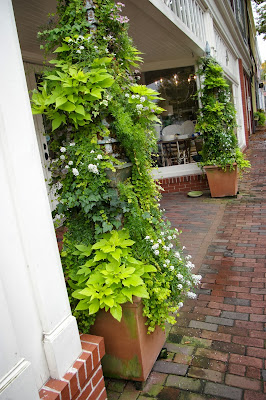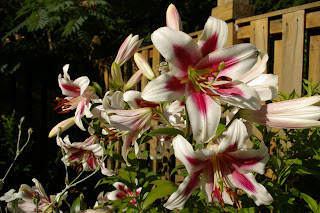Part Two
2013 was a very productive year in my edible garden. I managed to plant a reasonably good succession of vegetables from spring until fall. I had a few favorites, a few failures, and many happy successes. The last weekend of the year is a great time to review the good, the bad, and the delicious...
My number one success story is my new peach tree bed. In the fall of 2012 I decided to give my husband a peach tree for his birthday. He LOVES peaches. I spent many weekends digging out gooseneck loosestrife and sifting the soil to prepare it. I planted the tree and surrounded it with divisions of culinary chives plants, 5 'Top Hat' dwarf blueberries, and 5 assorted high bush blueberries. This bed is right next to my back garage, my garden shed of sorts, where I often sit to rest and survey my kingdom. The peach tree got lots of tender loving care, not to mention Organic Plant Magic, worm castings tea, and water. Well! We watched those peaches develop and ripen and when they were ready, they were the juiciest, most delicious fruit we have ever tasted.
My next success story was growing greens. I guess I have never really appreciated greens as much as I have this year. I had lettuce constantly, including in the summer when I planted varieties that could take the heat. I grew frisee endive, escarole, chicory, and spinach. I seeded them in early and again in late July. My fall crops of greens were unbelievable. Salads became a regular part of our diet.
2013 was the year I finally understood how to grow brocolli raab, one of my husband's favorite vegetables. I guess I was always expecting it to look like the bunches we bought in the store. Instead, I realized that I just had to keep picking those little flower heads every day, along with the young leaves, and they would keep forming for weeks and weeks. We ate so much of this healthy green vegetable that we couldn't believe it. I planted my first crop in April, with the moon phase. I planted my second crop in July, again in synch with the moon. I will not be without this plant in my garden again.
 |
| 'Summer Perfection' spinach produced all during the hot weather and into the fall |
I also had great success with a fall crop of bok choy and learned all kinds of interesting ways to make my own stir fries with fresh ginger root and other veggies. I intend to plant this again in 2014. It is really quite easy.
My biggest failure was that I neglected to THIN my fall crops of carrots and beets. They came up so profusely and then I got really busy. By the time I got back to them, they were all entangled and thinning was close to impossible. I will NOT do that again. I am going to try all kinds of ways of sowing these seeds so they are not so close together. I have heard that mixing them with sand helps. I have seen people make their own seed tapes. I could create a little template by drilling tiny holes in an old yardstick. Whatever... I love these root crops too much to waste them.
I grew the best crop of kale ever, but found out that, although I love to cook with kale, my husband didn't enjoy it at all. Naturally, my spring crop continued to produce great guns until late in the fall. I found myself bringing a lot of it into work to give away. I will probably still plant it next year, but a lot less.

My biggest frustration was my cucumbers. I actually created a brand new raised bed for them by my driveway because I had been plagued by disease and cucumber beetles in my main garden. At first they were very happy. By late summer, they started suffering from watersoaked spots on the leaves and the production diminished. This is one crop I need to really study. There is nothing like a cucumber tomato salad in the summer time.
Erich Bender, the veggie master at Natureworks, gave me a seedling of 'Cocozelle' squash early in the spring. That turned out to be the most productive summer squash plant I have ever grown. The vine survived surgery to remove squash vine borers and continued to produce delicious squashes right up until hard frost. That is a variety I will grow from now on. Thank you Erich!
The one thing I did differently in 2013 that really paid off is that I paid a lot more attention to watering my edible plants. We had a few long stretches of very dry weather, especially in the fall. I monitored the amount of moisture in the soil closely under the straw mulch. I do not have an irrigation system. My method was to use a series of buckets and watering cans. Each time I deep soaked my plants I treated them to either Organic Plant Magic or worm casting tea that I constantly brewed from tea bags in a large bucket. I would see the difference immediately.
All in all, I was quite pleased with my food production in 2013. I miss my garden already and have already eaten all of the potatoes I had stored. There are a few bags of peppers and green beans in the freezer, plenty of garlic still to enjoy, and a few bags of frozen plum tomatoes to make into sauce over the winter. Good thing that I can work on my seed orders now. It keeps my dreaming about all the food I will be growing in 2014.
What were your successes and challenges in YOUR edible garden?








































.jpg)


.jpg)


.jpg)
.jpg)
